|
|
|
| Published
on 11
Sep 2006 |
All rights reserved.
|
|
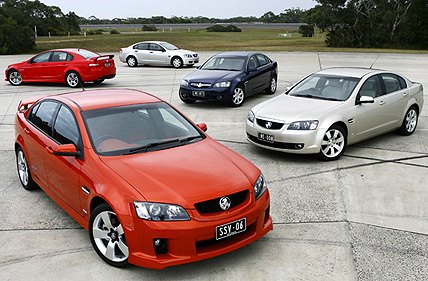 Holden
Commodore used to be a clone to Opel Omega. Although the 1997 VT
Commodore was said to be engineered in-house, its styling was
undeniably a copy of Omega and its technical specifications was heavily
influenced by the German car. However, since then the fortune has been
shifting to the Australian side. As European car buyers shifted towards
premium brands like BMW and Audi, Opel Omega could not escape from the
axe in 2003. In contrast, big saloons remain strong in the Australia
market. In 2004, Holden sold nearly 80,000 Commodores, enough to
justify the development of its own platform. Therefore GM invested
US$920 million into the VE Commodore program and assigned Holden the
responsibility to develop the rear-drive Zeta platform for the whole
group. Apart from Commodore, Zeta will be used in the next Chevrolet
Camaro and probably more GM cars for North America. Holden
Commodore used to be a clone to Opel Omega. Although the 1997 VT
Commodore was said to be engineered in-house, its styling was
undeniably a copy of Omega and its technical specifications was heavily
influenced by the German car. However, since then the fortune has been
shifting to the Australian side. As European car buyers shifted towards
premium brands like BMW and Audi, Opel Omega could not escape from the
axe in 2003. In contrast, big saloons remain strong in the Australia
market. In 2004, Holden sold nearly 80,000 Commodores, enough to
justify the development of its own platform. Therefore GM invested
US$920 million into the VE Commodore program and assigned Holden the
responsibility to develop the rear-drive Zeta platform for the whole
group. Apart from Commodore, Zeta will be used in the next Chevrolet
Camaro and probably more GM cars for North America.
The new Commodore is designed by Mike Simcoe, the same designer as
Monaro coupe. Although no longer related to Opel, it has strong visual
resemblance to the current Opel Vectra. It uses short overhangs and
aggressive wheelarches to deliver a compact and sporty appearance the
old car so lacked. In fact, the VE Commodore is larger than VT in every
dimensions - now its wheelbase measures a monstrous 2915mm, its length
and width are stretched to 4.9 meters and 1.9 meters respectively. By
European standard it will be slotted between a BMW 5-Series and
7-Series, yet in Australia it is just seen as a bread-and-butter family
car. This is one of the interesting features of Australian car market.
Australian cars tend to be jumbo size due to their wide roads, vast
parking spaces, low taxation and cheap fuel prices. Nevertheless, last
year the surging oil price has already taken a negative effect on their
sales, which saw Commodore dropped from 79,170 units to 66,794 units
and Ford Falcon even worse, from 85,500 to 53,080 units. The new
Commodore is more than 100 kg heavier than the last one, and its fuel
consumption increases a little bit. It seems to be a wrong decision to
grow larger.
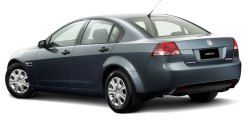 Anyway,
excluding fuel consumption, every aspect of the new Commodore has been
improved. Its chassis is 50 percent more rigid. Its crash worthiness is
substantially upgraded, as are NVH suppression and build quality. Its
suspensions are now mounted on subframes through rubber bushings. It
finally gave up the semi-trailing arm rear suspensions and adopted a
modern multi-link setup to improve ride and control. Its fuel tank has
been moved from the tail to ahead of rear axle in order to improve
weight distribution. All these changes are set to enhance handling and
driving fun. Anyway,
excluding fuel consumption, every aspect of the new Commodore has been
improved. Its chassis is 50 percent more rigid. Its crash worthiness is
substantially upgraded, as are NVH suppression and build quality. Its
suspensions are now mounted on subframes through rubber bushings. It
finally gave up the semi-trailing arm rear suspensions and adopted a
modern multi-link setup to improve ride and control. Its fuel tank has
been moved from the tail to ahead of rear axle in order to improve
weight distribution. All these changes are set to enhance handling and
driving fun.
And the result? Simply outstanding. The new suspension gives you an
impression of firm but controlled ride. On the one hand it soaks up the
worst bumps in Australia's country roads (not many European and
Japanese cars can do that), on the other hand it delivers excellent
body control, grip and predictability. The multi-link suspension has
sorted out the oversteer problem of the old car, giving the driver
confidence to push the car into corners and enjoy the ability of the
rear-drive chassis. Therefore the big Commodore feels much smaller than
it is. The no-nonsense hydraulic assisted, variable-ratio rack and
pinion steering also adds to the driving fun. It is light at the
straight ahead and weighs up nicely into corners. The turn-in is linear
and the steering is feelsome, a thing lost in almost all modern
European and Japanese saloons.
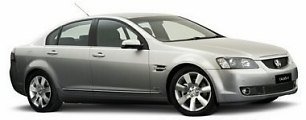 As
before, Holden offers it the homegrown 3.5-liter Alloytec DOHC V6 in
two states of tune – a 241hp version gets continuous VVT at intake
valves only and a single exhaust, while the upper-class engine employs
dual CVVT and twin-exhaust to enable 261hp. Unfortunately, with 1.7 ton
of kerb weight to haul, no matter which V6 is installed the Commodore
is still a little slow by class standard. Transmission can be either a
6-speed manual (for sporty model SV6), 4-speed automatic (for the most
popular base model Omega and mid-model Berlina), or 5-speed automatic
(for luxury model Calais). As
before, Holden offers it the homegrown 3.5-liter Alloytec DOHC V6 in
two states of tune – a 241hp version gets continuous VVT at intake
valves only and a single exhaust, while the upper-class engine employs
dual CVVT and twin-exhaust to enable 261hp. Unfortunately, with 1.7 ton
of kerb weight to haul, no matter which V6 is installed the Commodore
is still a little slow by class standard. Transmission can be either a
6-speed manual (for sporty model SV6), 4-speed automatic (for the most
popular base model Omega and mid-model Berlina), or 5-speed automatic
(for luxury model Calais).
For the top Commodores (model SS, SS-V or optional on Berlina), power
again comes from America - GM's Gen IV small-block V8. The 6.0-liter
all-alloy push-rod unit produces 362 horsepower and a monstrous 391
lbft of torque. Mated with a new 6-speed automatic it enables Commodore
SS to sprint from 0-60 mph in just 5.1 seconds ! but its fuel
consumption is equally appalling at 19.7 mpg.
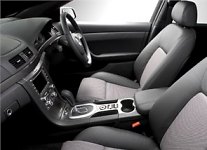 On
Australian roads at least, the new Commodore has no enemies to worry
about – Ford Falcon included, let alone those Japanese front-drivers.
Even a BMW 5-Series fails to ride and steer as well on their rough
roads. The outstanding driver appeal is perhaps the greatest
achievement of the VE program. On
Australian roads at least, the new Commodore has no enemies to worry
about – Ford Falcon included, let alone those Japanese front-drivers.
Even a BMW 5-Series fails to ride and steer as well on their rough
roads. The outstanding driver appeal is perhaps the greatest
achievement of the VE program.
Comfort and refinement are also vastly improved, just in a lesser
degree. You may say its interior design and materials are still
not up to the level of European offerings or Toyota Camry, but the
honest Australian probably don't care about that. They ask for a lot of
space and practicality at a bargain price, and they get them in the big
Commodore. Yes, it would have been better if the Commodore has stronger
and quieter V6 engines, lower fuel consumption and a smoother 4-speed
automatic, but even in current form it is good enough to be the best
big car available in the Australian market. My only concern is,
tailored made to the needs and taste of Australian, Commodore has
little prospect for export. |
Verdict:     |
Published
on 11
Sep 2006
|
All rights reserved.
|
|
Commodore SS-V
|
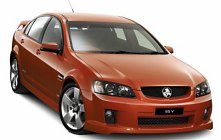 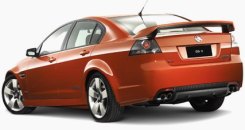
Although HSV (Holden
Special
Vehicle) version is in the pipeline, the production Commodore SS-V
still worth our attention, hence a separate article. In Australia it is
priced at an equivalent to US$40,000, the same as what Chrysler charges
300SRT-8 in the USA. However, its direct rivals are Ford Falcon XR8 and
XR6 Turbo.
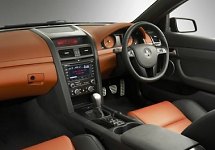 As
mentioned, the SS-V is powered by GM's Gen IV small-block ohv V8. It
displaces a full 6 liters and produces a respectable 362 horsepower at
5700 rpm, if not as impressive as Chevrolet Corvette's 400 horses.
However, there are 391 pound-foot of torque available at 4400 rpm, and
the majority of them arrive just above idle, so the driver can rely on
its torque to do the job rather than shifting the gearbox. There are
two choices for gearbox – GM's new 6L80 6-speed automatic and the
familiar Tremec T56 6-speed manual. The latter should have been a
driver's choice, but in fact there is little merit to choose it instead
of the automatic. Although its shift action and clutch operation have
been improved, it is still far from being a world-class transmission. As
mentioned, the SS-V is powered by GM's Gen IV small-block ohv V8. It
displaces a full 6 liters and produces a respectable 362 horsepower at
5700 rpm, if not as impressive as Chevrolet Corvette's 400 horses.
However, there are 391 pound-foot of torque available at 4400 rpm, and
the majority of them arrive just above idle, so the driver can rely on
its torque to do the job rather than shifting the gearbox. There are
two choices for gearbox – GM's new 6L80 6-speed automatic and the
familiar Tremec T56 6-speed manual. The latter should have been a
driver's choice, but in fact there is little merit to choose it instead
of the automatic. Although its shift action and clutch operation have
been improved, it is still far from being a world-class transmission.
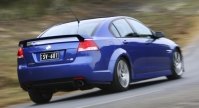 Holden claims the 6-speed
automatic can do 0-62 mph in 5.4 seconds (equivalent to 0-60 mph in 5.2
seconds), which is impressive considering the car seats 5 big guys and
weighs 1800kg. However, Chrysler 300SRT-8 is even more impressive – its
6.1-liter HEMI produces 60 more horsepower than the Holden and does
0-60 in 4.9 seconds. I also expect the Chrysler will beat the Holden
more convincingly at higher speed. On the other hand, BMW 335i sedan
will offer the same kind of performance at the same price (we are
talking of in a third-party country if it were exported) but trade
space for premium quality. This mean, while Commodore SS-V is cheap and
fast, it is not the last word for affordable performance sedans. Holden claims the 6-speed
automatic can do 0-62 mph in 5.4 seconds (equivalent to 0-60 mph in 5.2
seconds), which is impressive considering the car seats 5 big guys and
weighs 1800kg. However, Chrysler 300SRT-8 is even more impressive – its
6.1-liter HEMI produces 60 more horsepower than the Holden and does
0-60 in 4.9 seconds. I also expect the Chrysler will beat the Holden
more convincingly at higher speed. On the other hand, BMW 335i sedan
will offer the same kind of performance at the same price (we are
talking of in a third-party country if it were exported) but trade
space for premium quality. This mean, while Commodore SS-V is cheap and
fast, it is not the last word for affordable performance sedans.
Like
SV6 and SS, the SS-V gets stiffer sports suspension setup. In addition
to that is an aggressive aerodynamic / styling kit and 19-inch alloy
wheels. On Australian roads its ride feels firm but damp well, so it is
entirely livable as an everyday car. Body control and handling are
excellent, although keen drivers will definitely want its steering to
be weightier at the straight ahead position. They will also be
delighted if the exhaust note sound angrier. That said, Commodore SS-V
is faster, handles and rides better than its Ford rivals. That is
probably the only thing Australian muscle car fans concern. |
Verdict:     |
Published
on 28
Sep 2006
|
All rights reserved.
|
|
HSV GTS
|
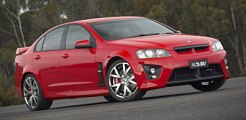 HSV,
or Holden Special Vehicles, was a joint venture between Holden and TWR
(Tom Walkinshaw Racing), but since TWR bankrupted in 2002 it became
wholly owned by Holden. Throughout the years HSV's main business was to
modify Commodore into performance cars. This goes like BMW's M-division
and Mercedes' AMG but HSV is far smaller and less well funded.
Therefore it always employs on-the-shelf components from the industry,
such as Detroit's V8 engines. HSV,
or Holden Special Vehicles, was a joint venture between Holden and TWR
(Tom Walkinshaw Racing), but since TWR bankrupted in 2002 it became
wholly owned by Holden. Throughout the years HSV's main business was to
modify Commodore into performance cars. This goes like BMW's M-division
and Mercedes' AMG but HSV is far smaller and less well funded.
Therefore it always employs on-the-shelf components from the industry,
such as Detroit's V8 engines.
The latest E-series GTS is no exception. Based on the VE generation
Commodore, it employs a version of Chevrolet Corvette's LS2 6.0-liter
V8, specially tuned to deliver 411 horsepower at 6000 rpm (versus
Corvette's 400hp) and 406 lbft of torque at 4400 rpm. Compare with the
standard Commodore SS, this V8 has the same capacity but it spins
noticeably freer at the top end and therefore produces 50 more
horsepower. Given so much capacity, it also produces abundance of low
to mid-range torque to enable strong in-gear acceleration. 0-60 mph can
be done in 4.8 seconds, accompany with 155 mph top speed. All sounds
good for a performance sedan costing just under £40,000.
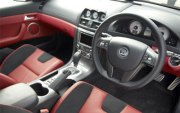 Nevertheless,
6 years ago its predecessor GTS 300 (whose name implies 300kW output,
or 400 horsepower) already boosted more or less the same acceleration
performance, plus an unlimited top speed believed to be around 170 mph.
At that time, European's top performance sedan BMW M5 had no more
horsepower than the GTS 300. Today, M5 and Mercedes E63 produce in
excess of 500 horsepower. This is progress. In contrast, HSV is still
standing at the 400 mark. It can no longer claim itself a giant killer.
We can't help feeling disappointed. Nevertheless,
6 years ago its predecessor GTS 300 (whose name implies 300kW output,
or 400 horsepower) already boosted more or less the same acceleration
performance, plus an unlimited top speed believed to be around 170 mph.
At that time, European's top performance sedan BMW M5 had no more
horsepower than the GTS 300. Today, M5 and Mercedes E63 produce in
excess of 500 horsepower. This is progress. In contrast, HSV is still
standing at the 400 mark. It can no longer claim itself a giant killer.
We can't help feeling disappointed.
Anyway, if you compare the new GTS to its predecessor, you will find
plenty of improvement in handling and ride quality. Undoubtedly, the VE
Commdore's stiff chassis, long wheelbase and wide tracks, modern
multi-link rear suspensions and better NVH engineering play an
important role. It corners with virtually no body roll. Its massive
tires generate massive grip. Its big disc brakes (365mm front and 350mm
rear, with 4-pot AP calipers) provide stronger stopping power than M5.
It tames its power much better than any previous HSVs, showing little
sign of uncontrollable wheelspin and oversteer if you push too hard in
bends. The ESC (Electronic Stability Control) also helps.
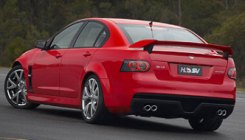 Equally
important is that HSV GTS has opted for Delphi's Magnetic Ride Control
(MRC), which uses electromagnetic medium to vary damping stiffness
continuously and provides the driver a selection between Performance
and Track mode. This technology has so far appeared only in Chevrolet
Corvette, Cadillac XLR, Ferrari 599GTB and Audi TT. Its development
costs a fortune to the low-volume HSV but the reward is equally great –
the GTS damps beautifully over different surfaces. It smoothens the
potholes that used to upset any previous HSV cars. Compare to the
non-MRC entry-level R8 Clubsport, the GTS rides more composed on the
backroads yet more comfortable on the highway. Equally
important is that HSV GTS has opted for Delphi's Magnetic Ride Control
(MRC), which uses electromagnetic medium to vary damping stiffness
continuously and provides the driver a selection between Performance
and Track mode. This technology has so far appeared only in Chevrolet
Corvette, Cadillac XLR, Ferrari 599GTB and Audi TT. Its development
costs a fortune to the low-volume HSV but the reward is equally great –
the GTS damps beautifully over different surfaces. It smoothens the
potholes that used to upset any previous HSV cars. Compare to the
non-MRC entry-level R8 Clubsport, the GTS rides more composed on the
backroads yet more comfortable on the highway.
The E-series GTS is no longer a clumsy drive like its
predecessor. Although there is little improvement in performance, it is
still a much better car overall. Of course, you can still pick a lot of
flaws from it, say, the American V8 is not as smooth as European
engines; the shift quality of Tremec T56 is still far from satisfying;
the cabin and overall build quality remains Aussie level… but for this
price you can probably ask no more. |
Verdict:     |
Published
on 5
Oct 2008
|
All rights reserved.
|
|
HSV W427
|
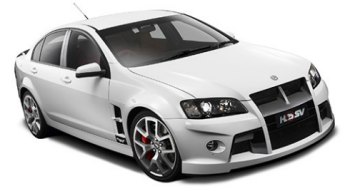
|
Does a super V8 justify a price higher
than Mercedes C63 AMG ?
|
In
Australia, HSV always represents great value for money compare with
imported performance sedans. For example, a 411-horsepower HSV GTS is
priced at just A$77,000, almost half the price of BMW M3 and Mercedes
C63 AMG. However, this tradition is going to be broken by a limited
edition model. HSV is going to produce 427 units of W427, each asks for
155,500 Australian dollars, or 10 percent more than our favourite C63
AMG. Is it crazy ?
In many aspects the W427 does not justify that amount of money.
Firstly, its exterior design is not particularly different from the
lesser GTS. Although the front end is made more aggressive, it looks
very aftermarket and hardly tasteful. The prominent rear spoiler of GTS
is even
replaced by a subtle boot lid spoiler (though made of carbon-fiber
now). The overall appearance cannot be described as an upgrade.
Secondly, the cabin remains cheap. The nasty plastics of standard
Commodore mix and match with in-your-face red leather trim and cheap
switch gears to deliver an especially poor visual effect. Again, we
found too few differences from the GTS.
Asking a premium price without delivering a premium package, W427 must
be much more powerful and faster than its European counterparts. Well,
the answer is both yes and no. As implied by its name, W427 is powered
by the 7-liter (or 427 cubic inches) LS7 V8 engine of Chevrolet
Corvette Z06. As you know, this engine has titanium con-rods, pushrods
and intake valves, 11.0:1 compression, forged aluminum pistons and
forged crankshaft to compensate for its inefficient OHV valvetrain. The
result is a remarkable 7000 rpm redline, 503 horsepower and 472 lb-ft
of torque. An HSV-tuned 2-stage variable exhaust produces great sound
at rev, while dry-sump lubrication lowers center of gravity hence
aiding handling. Power transmits to a Tremec TR6060 gearbox like
Corvette. LSD and electronic stability control are inevitable to handle
such a lot of power.
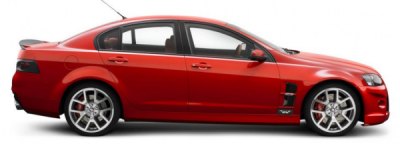
|
Subtle boot lid spoiler looks more
civilized than GTS
|
On the
road,
the LS7
engine delivers its power linearly. Below 4000 rpm, its extra punch
over GTS is not too obvious. Its true ability lies on the upper range.
Max torque and power arrive at 5000 rpm and 6500 rpm respectively, more
like a multi-valve engine. Of course, those pursuing the fun of high
revolution should look at BMW's smaller capacity V8 and V10 instead.
What you can't deny is the strength of the LS7 engine - it produces
some 92 horsepower more than the lesser GTS, 80hp more than M3 and
46hp more than C63 !
Unfortunately, handicapped by a near 1.9-ton body, the W427 is not as
quick as we hoped for. The company claims 0-62 mph take 4.7 seconds, a
couple of tenths slower than C63 AMG. Australian road testers usually
find the figures supplied by HSV range from accurate to optimistic, so
the conservatively rated German performance machines should have an
edge on the HSV in real world. The only area the latter beat them is
top speed, as it is electronically regulated at 270 km/h instead of its
rivals' 250 km/h.
The suspensions of W427 is about 30 percent stiffer and ride 20 mm
lower than GTS. The excellent MRC magnetic ride control, which utilizes
Delphi's electromagnetic-fluid adaptive dampers, is carried over. It
gives the W427 a surprisingly livable ride quality thus the car is
suitable for daily use. The handling of W427 is good, thanks to flat
cornering and progressive oversteer at the limit. However, with so much
torque going through the rear wheels, it is prone to wheelspin in low
gears. In wet condition traction control works overtime to contain
wheelspin. The W427 has stronger brakes than other HSV models - up
front are 380mm discs and 6-piston calipers, at the rear are 350mm
discs and 4-pot calipers - thus it provides confidence inspiring
braking. Most controls are well calibrated, except the Tremec gearbox
whose gearshift is still imprecise.
When Cadillac CTS-V abandoned the Corvette Z06 engine for a more
matured ZR1 supercharged engine, HSV W427 becomes the only 4-door sedan
in the world powered by this engine. However, exclusivity is not the
right reason to ask for absurd money. This car does not deliver any
higher performance per dollar than its European counterparts, so how
can it justify the far inferior quality, attention to details and brand
image ?
|
Verdict:    |
Published
on 25
Apr 2007
|
All rights reserved.
|
|
Holden Caprice / Statesman
|
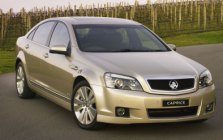 The
twins Caprice and Statesman are long-wheelbase luxury versions of
Commodore. Some 94mm of extra space is inserted between the axles to
create a super-roomy interior, while the overall length is extended by
266mm to enable a graceful tail and 535 liters of luggage space. In
other words, the twins are as large as a long-wheelbase Mercedes
S-class ! The extra length also improves their appearance – side
profile becomes sleeker and almost as handsome as Audi A8. What a pity
the fascia remains outdated. The
twins Caprice and Statesman are long-wheelbase luxury versions of
Commodore. Some 94mm of extra space is inserted between the axles to
create a super-roomy interior, while the overall length is extended by
266mm to enable a graceful tail and 535 liters of luggage space. In
other words, the twins are as large as a long-wheelbase Mercedes
S-class ! The extra length also improves their appearance – side
profile becomes sleeker and almost as handsome as Audi A8. What a pity
the fascia remains outdated.
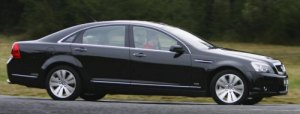 How to distinguish Caprice and
Statesman ? it's hard to tell from the look if you do not pay attention
to the detailed differences in their grilles. However, the Statesman is
designed to please old people and bosses who like to be driven, so its
suspension setting biases strongly towards comfort. The Caprice is on
the contrary, using firm suspensions and low profile tires to please
its drivers. Nevertheless, both cars can be chosen with the same 261hp
3.6-liter V6 and 362hp 6.0-liter V8 engine, just like Commodore, thus
there is no discernible differences in straight line performance. If
you choose the big V8, you will find the 1.8-1.9 ton limousines have a
surprising turn of speed, capable of doing 0-60 in 6.3 seconds.
Unfortunately, they drink gasoline equally fast... How to distinguish Caprice and
Statesman ? it's hard to tell from the look if you do not pay attention
to the detailed differences in their grilles. However, the Statesman is
designed to please old people and bosses who like to be driven, so its
suspension setting biases strongly towards comfort. The Caprice is on
the contrary, using firm suspensions and low profile tires to please
its drivers. Nevertheless, both cars can be chosen with the same 261hp
3.6-liter V6 and 362hp 6.0-liter V8 engine, just like Commodore, thus
there is no discernible differences in straight line performance. If
you choose the big V8, you will find the 1.8-1.9 ton limousines have a
surprising turn of speed, capable of doing 0-60 in 6.3 seconds.
Unfortunately, they drink gasoline equally fast...
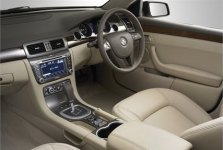 Compare with European premium
sedans like BMW 5-Series, the Australian homegrown limousines are
cheaper yet vastly more spacious. However, in terms of materials, build
quality or interior design, they are far from world class. Caprice and
Statesman were derived from the workman Commodore at a budget of only
US$150 million (on the top of the US$750 million budget for Commodore),
so how can they compete directly with European premium executive cars ?
Take the push-rod V8 for example. Powerful? certainly. Refined? No way.
The same goes for GM's 6-speed automatic transmission, which is no way
as smooth as ZF's or Mercedes' units. When you drive the Caprice
quickly, you will appreciate its body control, grip and steering, but
its suspensions are too hard for a luxurious car. In Statesman, the
situation is on the contrary, where body control and driving pleasure
are sacrificed for a pillowy ride. Many limousines are equipped with
adaptive damping or air suspensions to solve this problem, but sadly
the Holden duo did not do that as they were afraid to push the price
too high. So why does Buick Lucerne dare to employ Magnetic Ride
Control? Perhaps Holden should think again. Compare with European premium
sedans like BMW 5-Series, the Australian homegrown limousines are
cheaper yet vastly more spacious. However, in terms of materials, build
quality or interior design, they are far from world class. Caprice and
Statesman were derived from the workman Commodore at a budget of only
US$150 million (on the top of the US$750 million budget for Commodore),
so how can they compete directly with European premium executive cars ?
Take the push-rod V8 for example. Powerful? certainly. Refined? No way.
The same goes for GM's 6-speed automatic transmission, which is no way
as smooth as ZF's or Mercedes' units. When you drive the Caprice
quickly, you will appreciate its body control, grip and steering, but
its suspensions are too hard for a luxurious car. In Statesman, the
situation is on the contrary, where body control and driving pleasure
are sacrificed for a pillowy ride. Many limousines are equipped with
adaptive damping or air suspensions to solve this problem, but sadly
the Holden duo did not do that as they were afraid to push the price
too high. So why does Buick Lucerne dare to employ Magnetic Ride
Control? Perhaps Holden should think again.
Admittedly,
price is a very sensitive issue for Caprice and Statesman, as they are
mainly sold as company cars in Australia. The fleet market shrank
seriously in recent years to the extent that Ford is evacuating from
it. The Holden duo can still survive because they are also exported to
overseas market, under the name Chevrolet Caprice in the Middle East,
Buick Park Avenue in China and Daewoo Statesman in Korea. Still, Holden
does not expect to sell much more than 20,000 cars worldwide this year. |
Verdict:    |
Published
on 23
Feb 2008
|
All rights reserved.
|
|
Pontiac G8
|
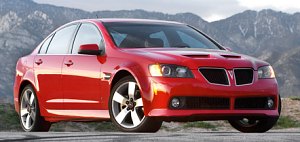 Having
failed the experiment of selling Holden Monaro in America as Pontiac
GTO, GM tries again with the new generation Holden Commodore. This time
it gets a new name, G8, so no more criticism could be aroused if it
does not fit into the character of existing Pontiac nameplates. Being a
large four-door sedan with strong sporting flavours, it could be an
answer to Infiniti G35, Chrysler 300C and even BMW 335i. Officially, it
is a new line in the Pontiac family tree. However, it is effectively a
replacement to the aging Grand Prix. Having
failed the experiment of selling Holden Monaro in America as Pontiac
GTO, GM tries again with the new generation Holden Commodore. This time
it gets a new name, G8, so no more criticism could be aroused if it
does not fit into the character of existing Pontiac nameplates. Being a
large four-door sedan with strong sporting flavours, it could be an
answer to Infiniti G35, Chrysler 300C and even BMW 335i. Officially, it
is a new line in the Pontiac family tree. However, it is effectively a
replacement to the aging Grand Prix.
Having North America market in signt right from development, Holden
Commodore does not need much modifications before going abroad. The
biggest change is the look, which features Pontiac's signature front
grille, twin-bumper intakes and a pair of fake cooling intakes on the
bonnet. It therefore seems to be sportier than the Australian car. In
fact, under the sheet metal is basically the same thing. The same
powertrains - 3.6-liter DOHC V6 with 5-speed automatic transmission and
6-liter push-rod V8 with 6-speed auto or manual - serve the G8. The
tuning is the same too, so the slight difference in power rating is due
to new SAE standard.
The V8 GT equipped with automatic tranny can do 0-60 in 5.3 seconds and
0-100 mph in around 13 seconds, faster than the aforementioned rivals
bar BMW. If you don't ask for class-leading refinement, it could be a
tempting choice. In the chassis department, thanks to the excellent
Commodore base, Pontiac finally has a car to rival the imports for
handling and ride. But then again, isn't itself an import too? |
Verdict:    |
Published
on 22
Nov 2008
|
All rights reserved.
|
|
6.2 LS3 engine to HSV GTS and
Pontiac G8 GXP
|
Earlier
this year HSV has upgraded its 6.0-liter cars to the new 6.2-liter GM
LS3 V8 (which made debut in Chevrolet Corvette). Max power increased by
14hp to 425hp, while max torque remains unchanged at 406 lb-ft. It
gives HSV GTS a moral victory over its arch rival Ford FPV Falcon GT
(with 422hp), but in real world the peformance gain is hard to detect.
Across the Pacific Ocean, Pontiac introduced a G8 GXP using the same
LS3 engine. Rated at 415 horsepower and 415 lb-ft, it is the equivalent
of HSV GTS thus becomes the new flagship model of G8. Performance is
significantly lifted from the existing G8 GT with 6.0-liter and 361hp,
especially when the optional 6-speed manual gearbox is selected. The
GXP is also benefited with better tires and Brembo brakes, just like
its HSV equivalent.
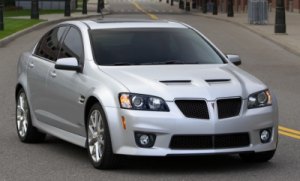 Pontiac G8 GXP Pontiac G8 GXP |
Verdict:    |
| Published
on 16
Aug
2013 |
All rights reserved.
|
|
VF Commodore
|
|
The current generation
Holden Commodore, or VE, is nearly 7 years old and it is time to have a
full generation changeover. However, considering its sales have been
falling steadily in recent years, from 80,000 units a decade ago to
just over 30,000 units last year, it is difficult to justify the
investment necessary for a full redesign. That is why Holden opted for
a mid-life makeover. The VF Commodore is still built on very much the
VE platform, as its unchanged proportion, body width and wheelbase
show. It focuses on updating the exterior and interior to keep up with
the new competition. In mechanical aspect, the number one job is to
lessen its notorious thirst for petrol. The outcome is not as
convincing as an all-new generation, of course, but it is able to keep
the car reasonably competitive for 3 or 4 more years, until the next
generation Commodore arrives.
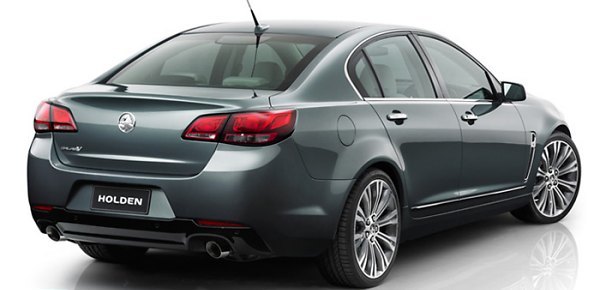
|
The VF has replaced all body panels except the doors and
roof. The nose and tail design has been modernized. Holden also took
this opportunity to cut weight. The bonnet and boot lid are converted
to aluminum, saving some 20 kg. The body-in-white monocoque is
lightened by 12.5 kg through the use of more high-strength steel and an
aluminum dash support beam. In the front suspension, the lower control
arms and knuckles are changed to cast aluminum to save another 12 kg.
Overall, the whole car is about 40 kg lighter than before, despite of
extra safety equipment. Meanwhile, the reshaped nose and tail lower
drag coefficient from 0.33 to 0.31. In addition to the switch to
electrical power steering, fuel consumption is reduced by 6.7 percent
on the base model.
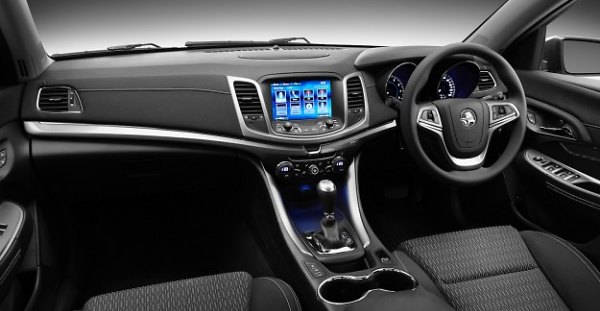
|
Inside, the cabin is completely revamped. The new dashboard
is far more stylish than the past. Materials are richer, although the
fit and finish still falls behind world standards, and some plastics
are still hard and scratchy. GM's MyLink infotainment system with
touchscreen is a welcomed update – frankly, without that it would not
be possible to survive in today's competitive market place. Cabin space
is still the Commodore's advantage, otherwise no one would consider a
car so big and heavy. There are not many affordable family cars can sit
3 adults comfortably at the back.
Powertrains are carried over from VE. There are two Alloytech V6s, a
3.0-liter with about 250 hp and a 3.6-liter unit with 280 hp, both are
completed with dual-VVT and direct injection and paired with GM's
6-speed automatic transmission. They are not exactly fast, as burdened
by a high kerb weight, so performance lovers will have to opt for the
6-liter small-block pushrod V8, which offers 350-360 hp depending on
transmission. 0-60 mph is guaranteed to be under six seconds. The
performance models are badged SS, SS-V or SS-V Redline. The latter is
the new range-topper, offering the stiffest suspension, largest Brembo
brakes, wider rear tires, faster ratio steering and launch control.
Expect 0-60 mph to take a little over 5 seconds and a lot of
oversteering fun in corners. Nevertheless, the lighter V6 offers better
balance, higher agility and a smoother ride.
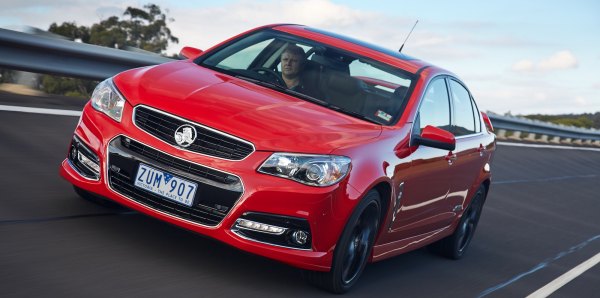
SS-V
Redline
|
Holden's
new electrical power steering is a rare success among its kind. It is
actually better than the old hydraulic rack, offering quicker on-center
response for sharper turn-in and a light yet progressive feeling. In
addition to the unique rear-drive dynamics, the Commodore is good at
delivering driving pleasure.
On the downside, the VF fails to match newer
rivals for build quality, engine refinement, sound insulation and
especially fuel
economy. Its lack of global exposure also hurts its chance for
long-term survival. While GM has committed to build the next generation
Commodore in Australia, we all know the days for the line is numbered.
The only way to survive is to globalize it, but then will it be the
Commodore that we used to know?
|
Verdict:    |
| Published
on 17
Aug
2013 |
All rights reserved.
|
|
HSV Gen-F GTS
|
|

|
High-performance Commodores
built by HSV (Holden Special Vehicle), the official tuning arm of
Holden founded by the late Tom Walkinshaw, has always been renowned for
performance bargain. While their build quality and technology are no
match with European performance sedans, their big Detroit V8s offer
comparable performance and sometimes even more raw fun. The latest
Gen-F is no exception.
It goes without saying that Gen-F is built on the VF Commodore, just
like the previous E-series that was derived from VE Commodore. It
enjoys the standard car's extensive update, especially the modernized
interior and lightweight aluminum components, but the limelight still
falls on the engine bay. Having tried a couple of Corvette V8s and even
the 7-liter engine from Z06 in the past, the new HSV range-topper lifts
the game to an unprecedented level – the 6.2-liter LSA supercharged V8
coming straight from Chevrolet Camaro ZL1. This heavyweight engine
produces an astonishing 585 horsepower and 546 pound-foot of torque
with the same calibration as the Chevy. These figures eclipse Audi RS6
as well as BMW M5, only edged out by Mercedes E63 AMG S in terms of
torque (while power is equal). Besides, the Tremec TR6060 6-speed
manual gearbox (with GM's 6L90E 6-speed auto as option) and heavy-duty
limited-slip differential with dedicated oil cooler are also
transplanted from the Camaro to the Australian car. As the Camaro's
Zeta platform is derived from the Commodore platform, this transplant
is easy.
HSV claims the car can do 0-100 km/h in 4.4 seconds, or 0-60 mph in
about 4.2 seconds. It might be slower than the 4-wheel-drive RS6 and
E63 AMG S 4matic, but it is right up there with M5 and Jaguar XFR-S.
Top speed is strictly regulated at 155 mph, unlike some rivals that can
be adjusted to 186 or 190 mph, but on Australian roads there is really
no point to go beyond 155.
Before we go on, I have to remind you that the Australian car costs
less than half the price of the aforementioned European rivals on its
home soil. In UK, where it is rebadged as Vauxhall VXR8 GTS, the price
gap is reduced to 30 percent or so. Still, it would be unfair to
compare it directly with the likes of M5. Comparison with M3 sedan, RS4
Avant or C63 would be more reasonable. Even so, such comparisons may be
like apple vs orange. Its combination of big power, big cabin and low
price continues to make it special on the marketplace.

|
On the road, the mega V8 is surprisingly quiet when you
drive at normal pace. Push harder and it reveals a more purposeful
noise. That noise is quite different to its rivals'. There is Detroit
V8 rumbles, of course, but dominating the soundtrack is the induction
sound rather than exhaust note, which shows how hard the Eaton TVS
supercharger sucking air. This is overlaid by a thin supercharger whine
on the background. It isn't as sophisticated sounding as the
turbocharged German motors, but it has its own character.
The heavyweight engine and transmission worsens the GTS' nose-heaviness
and increases its kerb weight to 1882 kg, so the car is not going to
feel agile. However, its handling and ride are much better than
expected. The new electrical power steering is more direct and precise.
The large AP brakes, with cross-drilled 2-piece ventilated discs
measuring 390 mm up front and 376 mm at the back, are powerful enough
to cope with its weight. The Delphi magnetorheological adaptive
dampers, now in Gen 3 (like Camaro ZL1, by the way), controls the body
motion admirably while delivering a comfortable ride. Better than its
German rivals, even in the sportiest mode the ride remains acceptable
on normal roads. This make the Australian car highly usable.
The new driver control system offers 4 modes, namely Touring, Sport,
Performance and Track. They alter exhaust noise, steering effort,
stability control, traction control, suspension stiffness, launch
control and the new torque vectoring. The latter applies soft braking
on the inside rear wheel to tame the nose-heavy car's inherent
understeer. This is quite effective, but it works only on power. If you
lift off throttle entering corners, you have to rely on conventional
technique for driving a powerful FR car. Fortunately, the big Commodore
is honest and easy to understand. You can play powerslide easily with
its deep reserve of torque. Just don't do that in a slow, second-gear
corner with electronics disabled. After all, anything with 550 lbft of
torque going through the rear wheels deserves respect.
The highlight of HSV GTS has always been performance per dollar. The
Gen-F update takes this to a higher level, but it also lifts the
standard of handling and ride, so dynamically it is at least a match to
European sports saloons. To certain extent it may be even more fun to
drive. It makes an M3 feels punchless, an RS4 sounds dull to steer and
an E63 horribly expensive. Yes, to choose this car over the established
European needs big courage (at least if you do not live in Australia or
New Zealand, where the price difference is huge). You have to sacrifice
the prestige badge and put up with a low-rent interior and bad-taste
exterior. If HSV can sort out these problems in the next Gen-G, it will
have a winner.
|
Verdict:     |
| Published
on 11
Dec
2013 |
All rights reserved.
|
|
Chevrolet SS
|
|
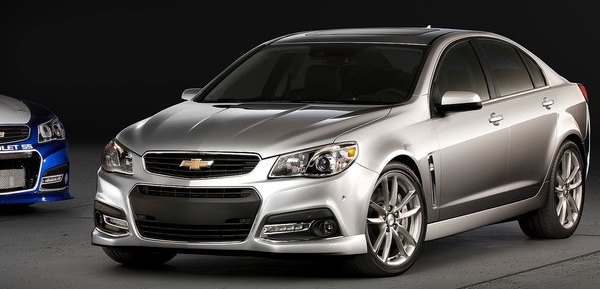
|
This is only a rebadged
Holden Commodore VF. That's all.
No, I am not going to stop here, because some of you come from the
United States and don't care about what Holden is selling in Australia
right now, so let me spend a few more paragraphs on the Chevrolet
version.
This is not the first time GM tries to sell the Commodore on US soil.
Back in 2008, Detroit imported the Australian car as Pontiac G8. With
V8 power, rear-wheel-drive and lots of cabin space, it should appeal to
traditional American motorists. Somehow, it didn't sell well. Following
the bankruptcy of GM and demise of Pontiac division, the car was gone.
Now the same strategy is resurrected with the Chevrolet SS badge. The
Commodore on which it is based is the recently updated VF series.
Compared to the old Pontiac it has quite a lot of advances, such as
aluminum bonnet, bood lid and suspension components as well as a
lightened steel monocoque which account for a 40 kg reduction in kerb
weight. A good electrical power steering replaces the old
hydraulic unit. Its interior is heavily revamped with better quality
materials, modern instruments, infotainment system and safety
equipment. The exterior design is also updated a little. The Chevrolet
SS is based on the Commodore SS-V Redline, sharing every body panel and
aerodynamic kits. Perhaps sales projection is not big, it does not seek
any differentiation in styling. Even the same front grille is used.
To save the need of re-certification, however, it continues to use the
old 6.2-liter LS3 V8 that served the last Pontiac G8 GXP. It pumps out
415 horsepower and equal number of pound-foot. This eclipses the
Australian car's 6.0-liter unit by a good margin, but on the downside
it
loses the latter's cylinder deactivation technology, so it is quite
thirsty by today's standard. GM could have dropped the new Corvette's
LT1 engine into the car, which comes with not only cylinder
deactivation but also direct injection and variable valve timing, but
again it won't be cost effective to do the re-engineering, considering
that only 5000 cars a year are projected to be sold in the stateside.
The V8 mates to the 6-speed
automatic transmission. The Commodore's manual option is not offered
due to lack of interest.
Predictably, the car drives very much the same as the Commodore SS-V
except being a little faster and rides a little smoother, as GM
softened its suspension a bit to please American drivers. For a car so
large, its handling is remarkable. Brembo front brakes, limited slip
differential and sticky Bridgestone rubbers give it a sporty edge, but
most important is a nicely balance chassis and a good-feeling steering.
If you seek old-school driving thrills, not many cars can offer this
level of satisfaction yet capable of seating 5 in comfort and without
costing your whole fortune.
|
Verdict:     |
|
|
|
|
|
|
|
|
|
|
VE
Commodore SV6
|
2006
|
| Front-engined,
RWD |
| Steel monocoque |
| Mainly steel |
| 4894 / 1899 / 1476 mm |
| 2915 mm |
V6, 60-degree
|
| 3564 cc |
DOHC 24 valves, DVVT
|
| VIM |
| - |
| 261 hp |
| 251 lbft |
| 6-speed manual |
F: strut
R: multi-link
|
| - |
| 245/45VR18 |
1730 kg
|
| 149 mph (c) |
7.0 (est)
|
| - |
|
VE
Commodore SS-V
|
2006
|
| Front-engined,
RWD |
| Steel monocoque |
| Mainly steel |
| 4894 / 1899 / 1476 mm |
| 2915 mm |
V8, 90-degree
|
| 5967 cc |
OHV 16 valves
|
| - |
| - |
| 362 hp |
| 391 lbft |
6-spd manual or 6-spd auto
|
F: strut
R: multi-link
|
| - |
| 245/40WR19 |
1800 kg
|
| 155 mph (limited) |
5.2 (c) (6A)
|
| - |
|
WM
Statesman V8
|
2007
|
| Front-engined,
RWD |
| Steel monocoque |
| Mainly steel |
| 5160 / 1899 / 1480 mm |
| 3009 mm |
V8, 90-degree
|
| 5967 cc |
OHV 16 valves
|
| - |
| - |
| 362 hp |
| 391 lbft |
6-speed auto
|
F: strut
R: multi-link
|
| - |
| 245/45WR18 |
1890 kg
|
| 155 mph (limited) |
6.3 (c)
|
| - |
|
|
|
|
|
Performance
tested by: -
|
|
|
|
|
|
|
HSV
GTS 6.0
|
2006
|
| Front-engined,
RWD |
| Steel monocoque |
| Mainly steel |
| 4943 / 1899 / 1468 mm |
| 2915 mm |
V8, 90-degree
|
| 5967 cc |
OHV 16 valves
|
| - |
| - |
| 411 hp |
| 406 lbft |
6-speed manual
|
F: strut
R: multi-link
|
Adaptive damping
|
F: 245/35ZR20
R: 275/30ZR20
|
1800 kg (est)
|
| 155 mph (limited) |
4.8 (c)
|
| - |
|
HSV
GTS 6.2
|
2008
|
| Front-engined,
RWD |
| Steel monocoque |
| Mainly steel |
| 4943 / 1899 / 1468 mm |
| 2915 mm |
V8, 90-degree
|
| 6162 cc |
OHV 16 valves
|
| - |
| - |
425 hp / 6000 rpm
|
406 lbft / 4600 rpm
|
6-speed manual
|
F: strut
R: multi-link
|
Adaptive damping
|
F: 245/35ZR20
R: 275/30ZR20
|
1789 kg
|
| 155 mph (limited) |
4.8 (c)
|
| - |
|
HSV
W427
|
2008
|
| Front-engined,
RWD |
| Steel monocoque |
| Mainly steel |
| 4974 / 1899 / 1462 mm |
| 2915 mm |
V8, 90-degree
|
| 7011 cc |
OHV 16 valves
|
| - |
| - |
503 hp / 6500 rpm
|
472 lbft / 5000 rpm
|
6-speed manual
|
F: strut
R: multi-link
|
Adaptive damping
|
F: 245/35ZR20
R: 275/30ZR20
|
1874 kg
|
| 168 mph (limited) |
4.5 (c) / 4.7*
|
| 10.1* |
|
|
|
|
|
Performance
tested by: * Wheels
|
|
|
|
|
|
|
Pontiac
G8
|
2008
|
| Front-engined,
RWD |
| Steel monocoque |
| Mainly steel |
| 4980 / 1899 / 1465 mm |
| 2915 mm |
V6, 60-degree
|
| 3564 cc |
DOHC 24 valves, DVVT
|
| VIM |
| - |
| 256 hp |
| 248 lbft |
5-speed automatic
|
F: strut
R: multi-link
|
| - |
| 245/45VR18 |
1785 kg
|
| 140 mph (limited) |
7.0*
|
| 18.5* |
|
Pontiac
G8 GT
|
2008
|
| Front-engined,
RWD |
| Steel monocoque |
| Mainly steel |
| 4980 / 1899 / 1465 mm |
| 2915 mm |
V8, 90-degree
|
| 5967 cc |
OHV 16 valves
|
| - |
| - |
361 hp
|
385 lbft
|
6-speed automatic
|
F: strut
R: multi-link
|
-
|
245/40WR19
|
1860 kg
|
| 155 mph (limited) |
5.3* / 5.3**
|
| 12.7* / 13.2** |
|
Pontiac
G8 GXP
|
2008
|
| Front-engined,
RWD |
| Steel monocoque |
| Mainly steel |
| 4980 / 1899 / 1465 mm |
| 2915 mm |
V8, 90-degree
|
| 6162 cc |
OHV 16 valves
|
| - |
| - |
415 hp
|
415 lbft
|
6-speed manual
|
F: strut
R: multi-link
|
-
|
245/40WR19
|
1824 kg
|
| 155 mph (limited) |
4.7*
|
| 11.4* |
|
|
|
|
|
| Performance
tested by: *C&D, **MT |
|
|
|
|
|
|
VF Commodore Evoke 3.0
|
2013
|
| Front-engined,
RWD |
| Steel monocoque |
| Mainly steel |
| 4947 / 1898 / 1471 mm |
| 2915 mm |
V6, 60-degree
|
| 2997 cc |
DOHC 24 valves, DVVT
|
| - |
| DI |
| 248 hp |
| 214 lbft |
| 6-speed automatic |
F: strut
R: multi-link
|
| - |
225/60R16
|
1622 kg
|
| 143 mph (est) |
8.2 (est)
|
| - |
|
VF Commodore Calais 3.6
|
2013
|
| Front-engined,
RWD |
| Steel monocoque |
| Mainly steel |
| 4950 / 1898 / 1471 mm |
| 2915 mm |
V6, 60-degree
|
| 3564 cc |
DOHC 24 valves, DVVT
|
| - |
| DI |
| 281 hp |
| 258 lbft |
| 6-speed automatic |
F: strut
R: multi-link
|
| - |
235/50VR18
|
1702 kg
|
| 152 mph (est) |
6.8 (est)
|
| - |
|
VF Commodore SS-V Redline
|
2013
|
| Front-engined,
RWD |
| Steel monocoque |
| Mainly steel |
| 4966 / 1898 / 1471 mm |
| 2915 mm |
V8, 90-degree
|
| 5967 cc |
OHV 16 valves
|
| - |
(6A: cylinder deactivation)
|
362 hp (6A: 348 hp)
|
391 lbft (6A: 381 lbft)
|
6-spd manual or 6-spd auto
|
F: strut
R: multi-link
|
| - |
F: 245/40WR19
R: 275/35WR19
|
1780 kg
|
| 155 mph (limited) |
5.4 (c)
|
| - |
|
|
|
|
|
Performance
tested by: -
|
|
|
|
|
|
|
WN Caprice V8
|
2013
|
| Front-engined,
RWD |
| Steel monocoque |
| Mainly steel |
| 5160 / 1898 / 1470 mm |
| 3009 mm |
V8, 90-degree
|
| 5967 cc |
OHV 16 valves
|
| - |
| - |
| 348 hp |
| 381 lbft |
6-speed automatic
|
F: strut
R: multi-link
|
| - |
245/40WR19
|
1851 kg
|
| 155 mph (limited) |
6.3 (est)
|
| - |
|
HSV Gen-F GTS
|
2013
|
| Front-engined,
RWD |
| Steel monocoque |
| Mainly steel |
| 4988 / 1898 / 1468 mm |
| 2915 mm |
V8, 90-degree
|
| 6162 cc |
OHV 16 valves
|
| Supercharger |
| - |
585 hp / 6000 rpm
|
546 lbft / 4200 rpm
|
6-speed manual
|
F: strut
R: multi-link
|
Adaptive damping
|
F: 255/35ZR20
R: 275/30ZR20
|
1882 kg
|
| 155 mph (limited) |
4.2 (c) / 4.6**
|
| 9.9** |
|
Chevrolet SS
|
2013
|
| Front-engined,
RWD |
| Steel monocoque |
| Mainly steel |
| 4966 / 1898 / 1471 mm |
| 2915 mm |
V8, 90-degree
|
| 6162 cc |
OHV 16 valves
|
| - |
-
|
415 hp
|
415 lbft
|
6-spd auto (6-spd manual)
|
F: strut
R: multi-link
|
| - |
F: 245/40WR19
R: 275/35WR19
|
1780 kg
|
| 160 mph (c) |
4.5* (4.6*)
|
10.5* (10.7*)
|
|
|
|
|
|
Performance
tested by: *C&D, **Autocar
|
|
|
|
|
|
|
|
|
Copyright©
1997-2013
by Mark Wan @ AutoZine
|
|